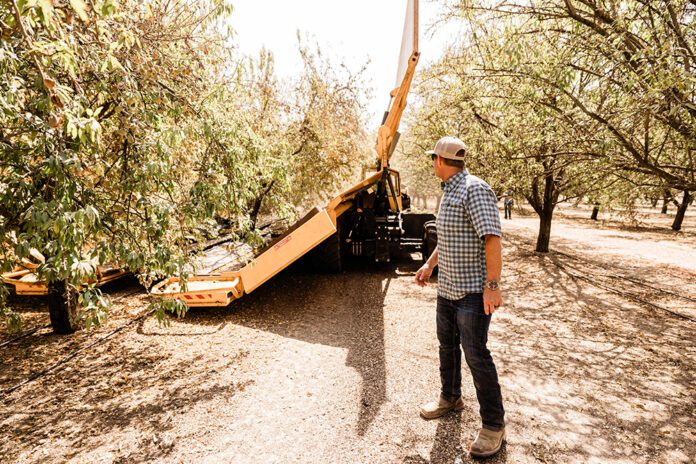
Despite being born into a farming family, Bret Sill of Sill Properties came late to almond growing as a profession. After growing up on the farm, he left for college and spent a good portion of his career in the produce industry, working in sales and marketing for a fresh-cut processor.
In 2015, he returned to the farm, becoming the fourth generation to work the land, and has never looked back. While Sill comes from a long line of growers, he’s not tied to the old ways of doing things. He is exploring regenerative farming and is excited about what the future holds with autonomous machinery and off-ground harvesting.
We asked Sill to give us his thoughts about the current and future state of the almond industry.
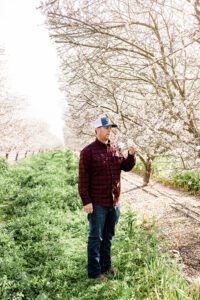
(all photos courtesy Sill Properties.)
Q. Tell us a little bit about the history of your farming operations.
We annexed our first piece of ground in 1898. My great-great grandfather when he came into town actually got started in farm implements, plows and stuff like that. Then when they annexed that ground, we got into farming and started with cotton.
When my dad took over the farm, we went from growing 2,000 acres of cotton and 160 acres of almonds and that was basically flip-flopped. So today, we actually don’t grow any cotton. We’re almonds, potatoes, garlic, carrots, corn, wheat and alfalfa.
Right now, I have two cousins that are involved in the farm. Nika, who’s in the office, is our controller, and then Ben, a PCA, handles daily activities on the ranch, runs the GUSSs (global unmanned spray systems) and all the contract to grow. My dad’s still involved as well. He’s the president and loves selling alfalfa.
Q. What made you want to get involved in the family farm?
I worked out here on and off as a kid. I first started hoeing weeds in the cotton field for $1.25 an hour. So, let’s just say I wasn’t enticed to come back, but I’d work some summers here and there at the farm.
In high school, I was working for an uncle doing some real estate stuff, so when I went to Cal Poly, San Luis Obispo, I got an ag business degree with finance and appraisal. When I graduated Cal Poly, I actually went to work for a grower-shipper in Oxnard, and they were doing fresh-cut greens like collard, mustard, turnip and kale. They started a processing facility there in Oxnard then we ended up expanding to Atlanta. I opened up a processing plant and was there doing the sales and marketing for them.
I lived out in Atlanta for 15 years. They ended up selling that portion of the business out to Del Monte, and I worked for them for a few years then started my own produce brokerage business. In 2012, we decided to move to California.
I still was doing produce when I moved back to California, then in 2015 I started on the farm. I’ve really kind of been around ag my whole life because out in Georgia, I was working with growers from Florida to Georgia all the way up to Wisconsin, so I’ve been involved in the growing side, but not actually in the farm doing it boots on the ground until 2015.
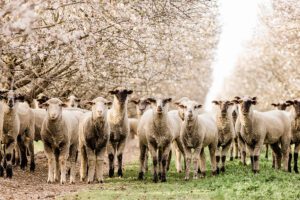
Q. Which job do you like better?
I love farming. I like it a lot better. I mean, I do miss some of the social things that we did in sales and marketing, but it changed so much in the produce industry with food safety and the retailers getting larger. Retailers have consolidated so much the past several years, and a lot of those smaller retailers have gone away or been bought out by the big box stores and it kind of took some of the fun out of it.
But I love being outside, and I love growing. And then just really looking at new ways that we can do to make it better. Not just better quality or not solely focused on yields, but what can we do to produce a healthier plant that will produce healthier soil, so that we can produce a more nutrient-dense almond that will then produce healthier people. That’s kind of my big focus now.
Q. Talk a little bit about what you’re doing to accomplish that goal with regenerative farming.
We started a few years ago just trying to back off on our synthetic fertilizers. We’ve taken 300 acres of almonds, and this was the first year with no synthetic fertilizer. We tried to limit some of the fungicide sprays. Some of it was the economics of almond markets and some of it was like, “Hey, let’s just try it.”
So, we tried several rows where we put on the nutritional spray instead of a fungicide spray, and did we see a difference? No, not really. It’s just easy for us to say, “Ok. We can take out the synthetic fertilizer. Now, let’s try and minimize the tillage in our wheat to corn plantings.”
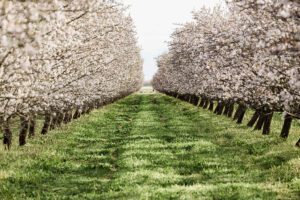
We’re doing cover crops. We’ve done them in the past but not intentionally. Now, we’re intentional on, “We’re going to put in a cover crop,” and we’re just not going to put in oats or wheat or just a barley or rye. We’re going to put in 10 to 12 different species.
So, we got some of the Seed for Bees seeds that they had through the Almond Board then just blended it up with different species. We wanted to complement the blend with some nitrogen fixation.
Last year, we planted a lot of cover crops in the almonds. This year, our goal is to plant every almond orchard that we have in cover crops then also bring in sheep to help cycle those nutrients instead of just mowing it down. A lot of people will terminate it with the spray, but let’s bring in sheep and they can forage on those cover crops and cycle the nutrients and put that back on the soil.
There’s a lot of benefits to having animals on the ground. We’ve had sheep in our alfalfa field for years. So, that’s where it really pushed us to try sheep in the almonds.
Having the cover crops in there helps not only with the nutritional value but then also brings in pests. If we allow nature to take its course, then theoretically you would have those good pests outcompete the bad pests, so you could limit some of those sprays that you do for pests. You can control the natural predators we have out there.
This year, we’re actually trying to get some funding to do pollinator habitat strips in a couple of the orchards as well to be able to have that after those cover crops are terminated. Then you still have flowering plants and brushes and shrubs that will bring in some of the pests that help control some of the ones we don’t want in there.
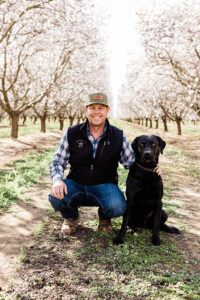
Q. When did you get interested in regenerative farming?
Probably a couple of years ago. I’ve really just started listening to a lot of podcasts on it and doing some research. I’ve listened to people like John Kemp. I’ve listened a lot to his podcast, and to me, it just made sense. I mean, it made sense that we can reduce some of our cost, that we can really start to focus on plant health and soil health, that we can let nature take its course and let that plant or let that tree actually build up the defense mechanisms to fight some of the diseases and pests.
It’s not going to happen overnight. I know it’s a process, but if that works and we can produce a more nutrient-dense product, then I think there’s value to that. As a grower, there’s only so much cost that we can cut cost out of what we do to be profitable. And right now, it doesn’t matter how much cost you cut off; it’s very difficult to be profitable when the almond market is $1.50 to $2.00.
So, how can we add value to that product? To me, it’s like, “Ok, if we can indeed show and test and prove these practices will help with more nutrients in the products that we grow, then we’ve added value.” Now, we must find out how we’re going to take that to market. And that’s a whole other difficult problem that we’re going to have to solve: taking this to market and telling that story and figuring out the supply chain because I believe our supply chain is thoroughly messed up. It rewards everyone in the middle, and the retailers are so competitive it keeps pushing back until it lands on the grower.
When they’re so competitive, they start to beat down the brokers and the marketers, then it comes down to the growers. We’re like, “What have we got?” We can’t sit there and do a fuel surcharge. We can’t say we’re going to charge at 8% profit. We’re just kind of stuck, and we need to fix that supply chain so we can make it a little more profitable for the farmers to do what they’re doing.
Q. What keeps you up at night related to growing almonds?
Well, I think I just said it. I think it’s the supply chain and really trying to figure out how to add value. We’re farmers. We’re not marketers. I have that in my background, but it’s not something that we’re set up to do, but that’s what kind of keeps me up is trying to figure it out.
How are we going to add value? I know there’s value to it, but then it’s very competitive. What are those products that we need to come up with and how are we going to market that and how are we going to add value to that so that we can get premiums? It is definitely on my mind.
And then two, just where do we go from here as far as the future and planning and stuff with the cost. To develop an orchard is so expensive. When do we say, “OK, it’s time to start planting again” because we’ve just been taking out old orchards and really scaling back there.
Some of the row crops have been a little bit better. I think they maybe have peaked at this point in time, so we have to see if now it is time to start planning more almonds. By the time these are ready in 2025 or 2026, is the market going to be turned around?
Q. What are you most hopeful for in the future when it comes to almonds?
Well, I think as far as almonds go, I’m really excited about off-ground harvesters, and I think there’s a lot of opportunities to save a ton on labor and equipment. For us, we have five shakers and four sweepers, three conditioners, three harvesters. If we can go to off-ground harvesters and go from say 20 engines plus all the labor to one or two machines, that’s a huge savings on our farm.
I believe if we can get to it, I think we’re still a long ways off, but if we can get to drying and make that feasible, I believe what we could do in the orchard would produce healthier soils, that it would almost offset the cost of drying them.
Also, what’s my savings if I eliminate all these machines and all this labor? Because we know labor’s not getting any cheaper, and these machines are definitely on the rise. It’s like everything that goes up, it rarely comes down. We’re probably seeing these pieces of equipment not going the other way in our favor, so I think if we could get to the off-ground and make it so that we’re saving but also improving the soil health because we’re not so much worried about floating the middles and mowing so much and we’re allowing those cover crops to grow. We can bring sheep in longer to cycle those nutrients in April and even into May. Then I think there’s just going to be some huge benefits for that.
Q. What do you think needs to happen to put the tree nut industry on the best possible path?
It’s going to be a lot of education. We’re going to have to educate a lot of growers that here are some of the benefits of what we’re doing if we do go to off-ground. Obviously, I believe the air board’s going to have to step in huge because they’re showing like 98% less dust if you don’t allow those nuts to touch the ground. What kind of incentives are going to be for the grower to then move to this type of equipment?
So you need the Almond Board, you need the Almond Alliance, you need the air board, you need all of them to start pushing for these policies to get put in place to make it advantageous for the grower to say, “Ok, I’m going to go buy a couple $500k machines and hey, some larger growers may need three or four,” because then you’re relying on that one machine. If it goes down, well, you got problems.
If your harvest is shut down, it shuts down everything, where if I just lose a shaker, if I just lose a sweeper, I’ve got other ones that are working. So, when you have one machine doing the whole thing, then you better have multiples of them.
Q. And what do you think are the biggest assets of the tree nut industry in California right now?
Coming from the produce industry and going to the PMAs and those big trade shows, when I first came into the almond industry and came to The Almond Conference, I was like, “Man, these guys were organized.” I mean, this is really just focused on this one variety. We’re not talking about apples to zucchinis and everything in between. This is all about almonds.
Going through some of their leadership programs, their Almond Leadership Program was really good for me because it was a fast track for me, too; get in and meet some people, figure out all the different aspects of the industry. That was a huge benefit.
I like the way they are focused and then just learning more about what they’re doing. As you know, we’re paying 3 cents and then, at the time, it got bumped up to 4 cents. And it’s like, “Ok, where’s that money going?”
It’s great to be able to get involved in the Almond Leadership Program to say, “Ok, yeah, look at their spending. They’re developing these markets, they’re doing these tests, they’re putting these funds together to help, and they’re doing these different things.” Just to be able to know that as a farmer and be able to share that with other farmers, I think, is a big benefit. It does come down to marketing. What the Almond Board does is marketing. You know, they hit a home run with Deion [Sanders]. Great timing and good forethought on that.
People need to know the Almond Board was behind it, and it’s helping promote almonds as a whole. So now we’re not so competitive, right? We’re almonds as a whole. We’re collaborating together. If we can collaborate together, we’re much better off than trying to compete. I think we need to collaborate more because if we can collaborate more and work together, then we’re going to benefit as a whole.
Q. What would you say has been the most beneficial thing or the thing that you’re proudest of as it relates to your professional development?
I say that is to be determined. I think if this regenerative ag can really pan out, and I am testing it, but I’m not saying that it is the way yet. I think we have a lot to prove, but if some of the statistics are true that we can produce more nutrient-dense almonds with these practices, then I think that is something that’s going to be a breakthrough for farmers to look at and go, “Ok. Hey, there’s different ways of doing this. We can improve our soil.”
The way we’re going right now, we’ve got 60 years left of topsoil. As a farmer, your ground, your soil is your biggest asset. So, what are you going to do to protect it? We need to take care of our soil so our soil can take care of us.
I think if some of these things that we’re doing on our farm with the regenerative ag lets us show that we’re going to have a more nutrient-dense product, then I think that’s going to be really big for our farm and for our industry and for the people that are eating our nuts.
Q. How do you give back to the community both in agriculture and in the community where your operation is based?
I think it’s important. Here in Bakersfield, we have so many farm workers that are in here for three to four months and working during harvest, whether it’s in almonds or pistachios or in grapes or in all the different row crops we grow here.
They’re here for a while, and they have a job and then they don’t. I think it’s important that we give back to our community, so in 2013, my wife and I started Morning Star Fresh Food ministry. It’s a ministry where we get meat from local butchers, fresh fruits and vegetables from local growers, and we deliver it to needy families with the love and hope of Jesus. I believe every person has the right to eat healthy food, not just people that can afford it. That has been one of our goals to make sure we have healthy, nutritious food, and we use that to get into the door so that we can then show the love and hope that Jesus would bring.
It has really been a passion of mine to do that, and with my background in the produce industry and now in almonds, I just know so many different growers that are so generous that it’s no big deal for them to give me a pallet of grapes or give me 40 boxes of potatoes or a 1,500 pound of yams. That’s not something that’s rejected, it’s not something that I’m picking up that had been there for three weeks. This is stuff I’m picking right up from the shipping docks of these produce houses. It’s fresh and it’s healthy and it’s nutritious.
Q. What advice do you have to a young person getting into farming tree nuts today?
Especially coming out of college or whatever, just try to get an internship with someone. There are so many aspects of the almond industry. Just go learn, try to get in with a good company that you know you can find someone that would mentor you.
There are opportunities. There are a lot of programs out there that could help a young farmer get established. Some young farmers start off with 40 acres. Is it going to be their full-time job at 40 acres? No. You’re going to have to have another job, but it will help you get started. As you grow and learn more, the more opportunities you can find.
There are a lot of programs out there like this community solar going on where you can put 5 to 10 to 15 acres of solar in there. You can go buy a piece of land and have some of that revenue on the solar to help pay some of your mortgage.
It’s pretty tough right now to be able to buy land. It’s so expensive, and some of the returns on some of the products that we’re growing are below the cost to produce. It’s going to make it tough, but with all the different trials and tribulations that are going on right now in our state of economy, there’s always going to be some opportunities to buy.
Just look for those and look at the different programs that are out there that will help new farmers and young farmers, and you never know what’s going to happen.
Q. Did you have a mentor, somebody that helped you as you were making the transition to almonds?
My dad was really great. He just kind of took me in. Even though I didn’t have a lot of that experience in the field, he was able to teach me some of that. My dad’s just been a great mentor of mine, and really showed me the ways and the path. He’s built a successful company here, so he’s been doing things right and is very respected in the industry.
Q. What do you think the biggest advancement has been in tree nuts during your time in the industry?
I think we’re seeing some of that come along right now with some of the autonomous advancements. I think that’s a huge win for the industry because you’re reducing quite a bit of labor. Like for us, with the GUSSs, we’re going from an eight-man crew to a two-man crew and pretty much getting close to the same number of acres done at night.
Now, we’re seeing things with the autonomous shakers coming along, and I think those are going to be big as well as off-ground harvest. I think that’s going to be something that’s going to really change the industry and what we’re doing.
Q. Talk a little bit about the water situation in California and how that affects tree nut growing.
SGMA is really a huge thing right now, and it’s a policy that’s in place that’s not going to go away. Even though we had tremendous wet weather last year and hopefully recharged a lot of water into the ground, it’s not going away, so you need to get involved in your local irrigation districts. You need to get involved in some of those policies that are getting put in place because if we allow all the consultants and all the attorneys to do that with no input from the farmers, then we’re going to wake up one day and go, “What the heck has happened?”
It’s important to know what’s going on because water is not something that we can change. Water is our lifeline, and it takes a lot of water to grow every crop we grow.
It’s really just attending some of those meetings that are going on and paying attention to the policies that are getting put in place and talking with your irrigation manager and even some of the attorneys I have to deal with, just having relationships with them, trying to figure out what can we do to make this work? What kind of technology can we [use] to help recharge?
We have a pilot program going on right now, or that’s going to be started, that we’re going to use some of the technology in the oil industry to do some horizontal drilling on ground that is under an easement. Just thinking outside the box and trying to figure out different technologies of what we can do to recharge the water under the ground because that’s our biggest aquifer, and we need to take advantage of that because we’re going to have dry years and we’re going to need to pump.
Just get involved, go to those meetings, get involved with the irrigation districts and know what’s going on. Don’t wait because by the time you get involved, it’s going to be too late. Do something now.










